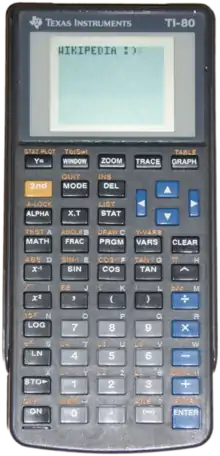TI-80
The TI-80 is a graphing calculator made by Texas Instruments. It was originally designed in 1995 to be used at a middle school level (grades 6-8).
 | |
| Type | Graphing calculator |
|---|---|
| Manufacturer | Texas Instruments |
| Introduced | 1995 |
| Discontinued | 1998 |
| Successor | TI-73 series |
| Calculator | |
| Entry mode | D.A.L. |
| Precision | 13 |
| Display size | 64×48 pixels, 16×8 characters |
| CPU | |
| Processor | Proprietary (on board a Toshiba T6M53 or T6M53A ASIC) |
| Frequency | 980 kHz |
| Programming | |
| User memory | 7 KB of RAM |
| Other | |
| Power supply | 2 CR2032 batteries |
| Weight | 106 grams (3.7 oz) |
| Dimensions | 163 mm × 71 mm × 15 mm (6.4 in × 2.8 in × 0.60 in) |
The TI-80 featured a 48 x 64 dot-matrix display with a 5 x 3 pixel font, which is the smallest screen of any TI graphing calculator. It also featured the slowest processor (980 kHz proprietary) of any TI graphing calculator. The first revision of the TI-80 'A' contained a proprietary Toshiba T6M53 ASIC while subsequent revisions contained a Toshiba T6M53A. Additionally, the TI-80 had the processor on board the ASIC, unlike later calculators like the TI-83, TI-83 Plus, and TI-84 Plus which had separate ASIC and processor chips in certain models. In comparison, the TI-81, released in 1990, featured a 2 MHz Zilog Z80 processor. However, the TI-80 did feature 7 KB of RAM (compared with the TI-81's 2.4 KB). The TI-80 also had more built-in functions than the TI-81 (such as list and table functions, as well as fraction and decimal conversions). Like the TI-81, the TI-80 did not feature a link port on the base model, however, unlike the TI-81, the ViewScreen variant (meant for use with TI's overhead projection units) did. The TI-80 was also the only graphing calculator to use 2 CR2032 lithium batteries (instead of the standard 4 AAA batteries with a lithium backup battery).
Since its release, it has been superseded by the superior TI-73 and TI-73 Explorer. The TI-80 was officially discontinued in 1998, when it was replaced by the TI-73, however, production continued until at least October 2000.